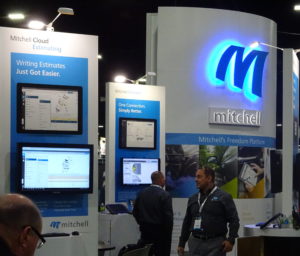
Mitchell purges categories after Calif. regulators say no to ‘Opt-OE’
By onBusiness Practices | Market Trends | Technology
Mitchell last week said it eliminated “parts labeled as variations of OE” following California regulators’ 2018 guidance to collision repairers and insurers against using such vague categories.
The California Bureau of Automotive Repair last year retooled its regulations to emphasize that body shops shouldn’t be identifying parts with nebulous terms like “Opt-OE.”
The BAR hasn’t actually changed its stance on parts disclosure, the new wording of its regulations merely serves to “reclarify our position,” BAR Northern California enforcement program manager II Tim Bowden said in September 2018.
The BAR had seen a trend of parts being labeled with vague terms like “LKQ” or “Alt-OE.” Bowden said such a label “does not meet the requirement” of telling customers what kind of parts are actually being installed.
That kind of terminology would also be an unfair claims settlement practice, California Department of Insurance general counsel and Deputy Commissioner Kenneth Schnoll wrote in October 2018 to the California Autobody Assocation, which had sought a legal opinion on the behavior.
“Accordingly, because insurers are required to follow the same standards as auto body collision repair shops in connection with repair estimates, insurers are also prohibited from using any description of any replacement part other than new, used, reconditioned, rebuilt, an OEM crash part, or a non~OEM aftermarket crash part,” Schnoll wrote.
“Each part listed in the estimate shall be new unless specifically identified as a used, rebuilt or reconditioned part,” 16 CCR 3353 states now following the BAR’s clarification. “Each new replacement crash part listed in the estimate shall be an original equipment manufacturer (OEM) part unless specifically identified as a non-OEM aftermarket crash part.
“We removed the ability to show parts labeled as variations of OE (Opt OE, OE Surplus, etc.) from UltraMate printed estimates in order to be compliant with the BAR – and our modifications were reviewed with BAR representatives,” Mitchell repair sales and service Vice President Jack Rozint wrote in an email Wednesday.
” … We continue to work with the BAR, CIECA, CIC, and our customers to come up with mutually agreeable, standardized methods to refer to parts depending on the purchase channel, discounts, sources, and warranties.”
Rozint noted that other post-estimate systems could still identify OEM parts sourced outside of the official, authorized automaker-dealer-shop supply chain, such as “Shop Management Systems, insurer communications, reporting databases, etc.”
Despite the BAR and CDI nixing “Opt-OE” terms in one of the nation’s biggest markets, CCC said it hadn’t stripped out such parts categories.
“CCC has no current plans to change the available part type designations within its system,” CCC wrote in an email Monday. “The use of any part on a given estimate remains up to the individual estimator.”
We put a similar question to Audatex, but while a representative did initially reach out asking for more details about the inquiry, we received no response under the timeline we provided. Continue to check Repairer Driven News for updates.
The “OEM Discount,” or “OEMD” category remains in Mitchell UltraMate.
“If you use the drop down on a line to change the part type to OEMD, the part # and part price will be blanked out (allowing the user to manually enter those) and the line will be designated with an asterisk (*), indicating a judgement by the user,” Rozint wrote. “As an OEM Discount part is by definition an OEM part, it prints on the estimate as OEM.”
Rozint said the system will also classify a vendor into OEMD or one of the other parts categories based upon how it has described itself to Mitchell.
Andrew Batenhorst, body shop manager for Pacific BMW, had contacted us about third-party parts suppler Elite Euro Parts linked to the term OEMD in Mitchell.
In one instance, the part number was accompanied by a “^^.” The part number and “^^” were seen again associated with the part under Elite Euro Parts’ name and address — except Elite Euro Parts was renamed “ELITE EURO PARTS OEMD.”
Mitchell’s system will automatically classify vendors like Elite based on how they’ve described themselves to the estimating service, Rozint explained. Rozint said the software will add symbols like the “^^” and OEMD in that process.
California-based Elite Euro Parts partner Mark Asad said he hadn’t heard of the new formatting. He said Elite had submitted its parts and prices list to Mitchell three years ago and hadn’t updated it since hearing of the state’s position. (The agency also addressed the subject in 2016.)
“We haven’t submitted anything after that,” Asad said.

Asad said his company provided the original invoices from dealerships with its parts, demonstrating their provenance.
The state of California currently defines an OEM part warrantied by a third party as OEM — though this might change down the road.
The BAR is examining tightening up the definition of “OEM crash part” to exclude parts not recognized by the automaker or sold through the official authorized channel. It also might add “bonded glass” to the category of “crash part.”
More information:
“Bureau of Automotive Repair Collision Repair Proposals Workshop – April 18, 2019”
California Department of Consumer Affairs YouTube channel, April 18, 2019
Bureau of Automotive Repair proposed collision repair regulations
BAR, April 18, 2019
Images:
The Mitchell booth at NACE 2018 is shown. (andriano_cz/iStock)
Elite Euro Parts said the “^^” and renaming of the company to “ELITE EURO PARTS OEMD” in this insurance-provided estimate wasn’t its doing. (Mitchell screenshots)
